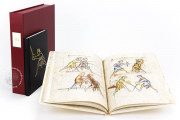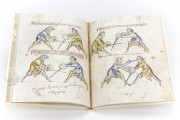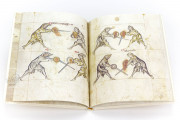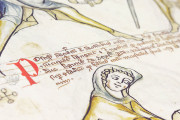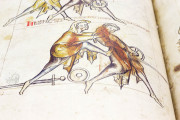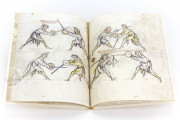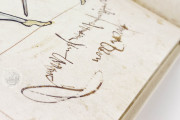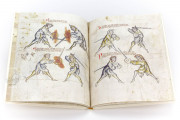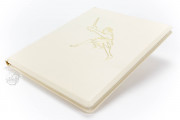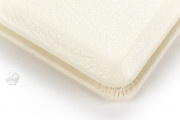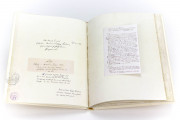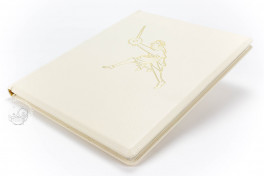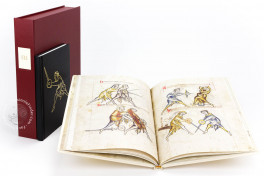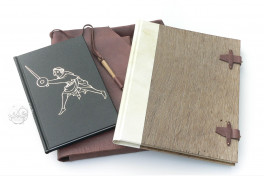A Fightbook (Fechtbuch) is a manual for the instruction of martial arts. They enjoyed popularity in Europe from the fourteenth century onward. This manuscript, also called the Tower, Walburgis or Luitger Fightbook, is the oldest known example. Its sixty-four pages are filled with 128 illustrations in which two figures, a Priest and a Student, demonstrate the various instructions presented in the Latin text.
Made in Germany in the early fourteenth century, it has the additional curiosity of depicting a woman identified as Walpurga combatting the Priest in the final folio, defeating him because “she was above the first to be ready.”
Although the exact workshop is unknown, academic interest in the study of combat techniques coincided with the establishment of cathedral schools and universities in the Gothic period and it may have been made near such a foundation. With its numerous marginal additions, this book saw use over many centuries and the absence of gold or unnecessary elaboration suggest this was a practical book for instruction and learning.
A Treatise on Combat with a Sword and Buckler
This fightbook focuses exclusively on techniques for a one-handed arming sword and small hand-held shield called a buckler. Both the Priest, who is the master, and the Student, who is the learner, are armed identically and wear no armor suggesting this manual is a study in the art of fencing rather than deadly combat. The two figures are rendered similarly in loose belted robes with hose and low shoes, with the Priest shown tonsured and the Student wearing his hood. The men often have charming, smiling expressions and occasionally look out at the reader.
Walpurga is the most detailed figure. She wears a fashionable tight-sleeved tunic with buttons on the forearms over which is a belted surcoat. Walpurga is a saint popular in northern Europe, however this figure bears no halo and her long hair is loose and uncovered suggesting that she might represent a specific person or, perhaps, patron.
Illustrative Pictures and Explanatory Text
As an instruction manual, this fightbook affords primacy to the pictures. The illustrations were executed before the text indicated by the way in which the ruling and script have been positioned around the figures. The text is written in three different hands. Two capable scribes wrote in a standard Gothic textualis. The third’s script is spindly and not a practiced book hand. This third hand also made corrections suggesting he may have been the master of the workshop or perhaps the “Lutiger” referred to in the text.
While the main language is Latin, German words occur with some frequency to describe weapons or movements for which the Latin was unknown or was simply incapable of providing an accurate description. Rubrication is used throughout and red lines as strikethroughs are used to highlight portions of the text.
The Fightbook as the Spoils of War
The exact origins and early life of this fightbook are unknown. It was likely made at or for a cathedral school, such as Heidelberg, in modern day Germany. It was housed in an unknown Francian monastery until it was taken during a period of conflict in the mid-sixteenth century and through a series of owners ended up in the Saxe-Gotha ducal library.
It disappeared during World War II and resurfaced as a lot in Sotheby’s in 1950, where it was purchased by the Royal Armories. It was kept at the Tower of London until the relocation of the collection to Leeds in the 1990s.
We have 2 facsimiles of the manuscript "Illuminated Fightbook":
- Illuminated Fightbook - The Royal Armouries Edition facsimile edition published by Extraordinary Editions, 2013
- Illuminated Fightbook - The Exemplary Edition facsimile edition published by Extraordinary Editions, 2013


